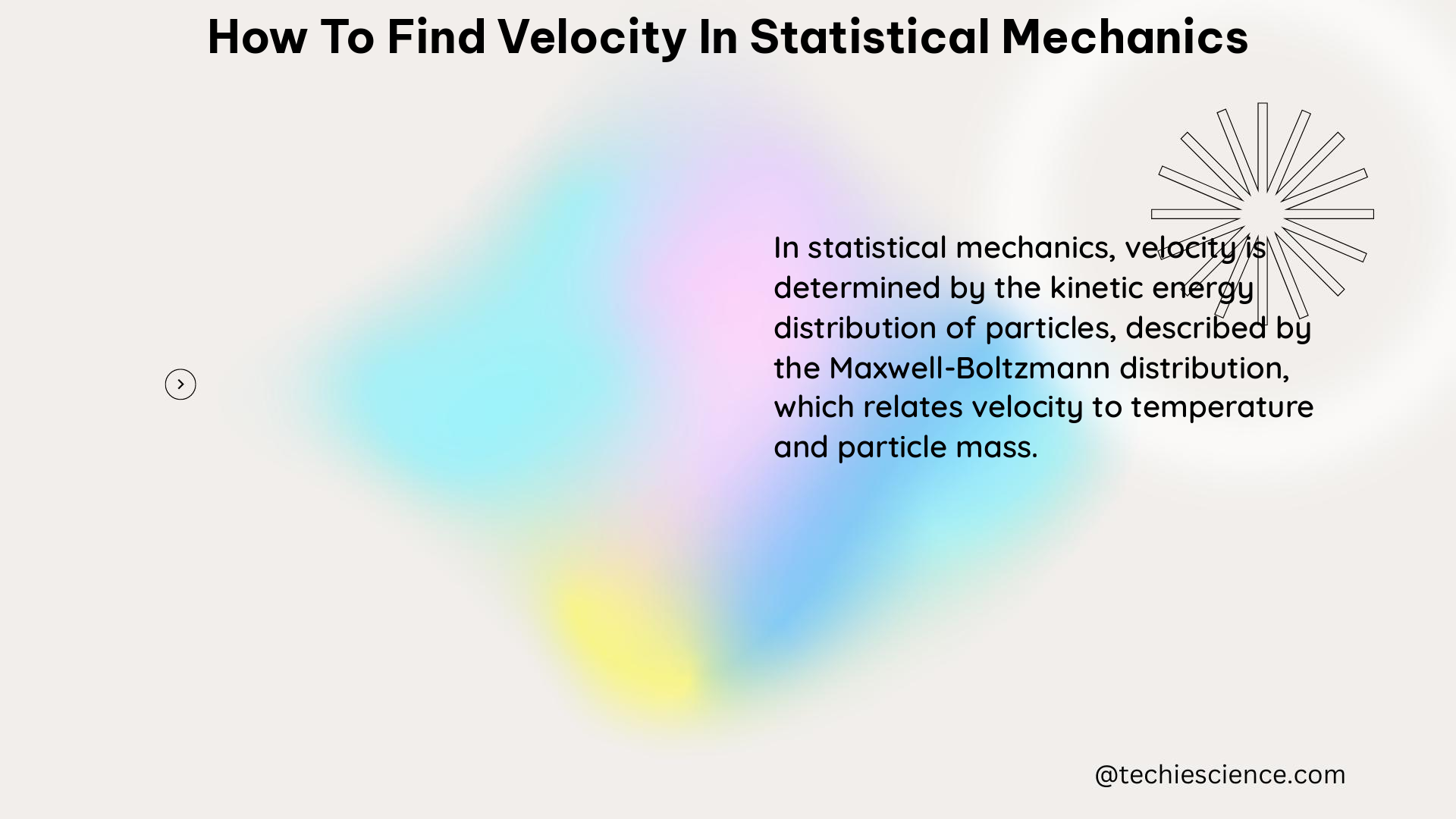In the realm of statistical mechanics, understanding the velocity distribution of particles is crucial for analyzing the behavior of various systems, from gases to condensed matter. This comprehensive guide will delve into the principles and techniques used to determine the velocity in statistical mechanics, providing you with a detailed and practical understanding of this fundamental concept.
The Maxwell-Boltzmann Distribution
The cornerstone of finding velocity in statistical mechanics is the Maxwell-Boltzmann distribution, which describes the probability of finding a particle with a certain velocity. This distribution is given by the equation:
f(v) = 4π(m/2πkT)^(3/2) v^2 exp(-mv^2/2kT)
where:
– f(v) is the velocity distribution function
– m is the mass of the particles
– k is the Boltzmann constant
– T is the absolute temperature of the system
The Maxwell-Boltzmann distribution can be derived from the Boltzmann equation or the principle of maximum entropy, and it provides a fundamental understanding of the velocity characteristics of a system.
Calculating the Mean Velocity and Velocity Dispersion

To determine the mean velocity and velocity dispersion of a system, we can use the following formulas:
- Mean Velocity:
<v> = ∫vf(v)dv / ∫f(v)dv
- Velocity Dispersion (Root Mean Square Velocity):
<v^2> = ∫v^2f(v)dv / ∫f(v)dv
These integrals are taken over all possible velocities, and they provide the average velocity and the spread of velocities within the system.
Example: Nitrogen Gas at Room Temperature and Pressure
Let’s consider a gas of nitrogen molecules at room temperature (298 K) and atmospheric pressure (1 atm). We can use the Maxwell-Boltzmann distribution to calculate the most probable velocity and the root mean square velocity.
- Most Probable Velocity:
v_mp = sqrt(2kT/m) = 422 m/s
where m is the mass of a nitrogen molecule (28 g/mol).
- Root Mean Square Velocity:
v_rms = sqrt(3kT/m) = 515 m/s
These values provide insights into the typical velocities of the nitrogen molecules in the system, which can be useful for understanding the system’s behavior and properties.
Molecular Dynamics and Monte Carlo Simulations
To further explore the velocity distribution of a system, researchers often employ molecular dynamics (MD) or Monte Carlo (MC) simulations. These computational techniques are based on the principles of statistical mechanics and allow for the calculation of individual particle trajectories and the corresponding velocity distribution functions.
MD simulations solve the equations of motion for each particle in the system, while MC simulations use random sampling to explore the phase space of the system. Both methods provide valuable insights into the velocity characteristics of the system and can be used to validate the analytical results obtained from the Maxwell-Boltzmann distribution.
Practical Applications and Considerations
The understanding of velocity in statistical mechanics has numerous practical applications, including:
- Gas Dynamics: Analyzing the behavior of gases, such as in the design of internal combustion engines or the study of atmospheric phenomena.
- Plasma Physics: Investigating the velocity distribution of charged particles in plasmas, which is crucial for understanding phenomena like fusion reactions and plasma processing.
- Condensed Matter Physics: Studying the velocity distribution of particles in solids and liquids, which can provide insights into phase transitions, thermal transport, and material properties.
- Astrophysics: Analyzing the velocity distribution of stars and other celestial bodies to understand the dynamics of galaxies and the evolution of the universe.
When working with velocity in statistical mechanics, it is important to consider factors such as the system’s temperature, pressure, and the specific properties of the particles involved. Additionally, the choice of simulation method (MD or MC) and the level of detail required in the analysis can significantly impact the accuracy and computational complexity of the results.
Conclusion
In summary, the determination of velocity in statistical mechanics is a fundamental aspect of understanding the behavior of various physical systems. By mastering the principles of the Maxwell-Boltzmann distribution, the calculation of mean velocity and velocity dispersion, and the utilization of computational simulations, you can gain a comprehensive understanding of this crucial concept in statistical mechanics. This knowledge will empower you to analyze, interpret, and apply the principles of velocity in a wide range of scientific and engineering applications.
References:
- Kinetic Theory and Statistical Physics by David J. Griffiths
- Statistical Mechanics by Leonard Susskind and Art Friedman
- Introduction to Statistical Mechanics by David Chandler

The lambdageeks.com Core SME Team is a group of experienced subject matter experts from diverse scientific and technical fields including Physics, Chemistry, Technology,Electronics & Electrical Engineering, Automotive, Mechanical Engineering. Our team collaborates to create high-quality, well-researched articles on a wide range of science and technology topics for the lambdageeks.com website.
All Our Senior SME are having more than 7 Years of experience in the respective fields . They are either Working Industry Professionals or assocaited With different Universities. Refer Our Authors Page to get to know About our Core SMEs.